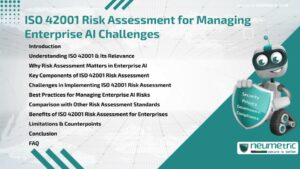Table of Contents
ToggleIntroduction
The WAF enterprise compliance Framework is a structured approach that helps Organisations deploy Web Application Firewalls [WAFs] in line with Cybersecurity regulations & standards. It enables enterprises to strengthen Data Protection, manage Risks & ensure compliance with international laws. As businesses expand globally, frameworks become necessary to unify security practices, reduce Vulnerabilities & demonstrate accountability. This article explains the role of WAFs in enterprise Cybersecurity, outlines the key standards that shape compliance & provides actionable insights for implementation.
Understanding WAF in the Enterprise Context
A Web Application Firewall [WAF] monitors & filters traffic between users & web applications. In an enterprise context, WAFs safeguard high-volume, complex environments such as e-commerce platforms, Financial systems & Healthcare portals. They detect & prevent attacks like SQL injection, cross-site scripting & credential stuffing. Just as airport security screens passengers before they board, WAFs screen traffic to block malicious activity while allowing legitimate requests.
Why a WAF Enterprise Compliance Framework is Essential
For enterprises, compliance is not optional-it is a legal, operational & reputational necessity. A WAF enterprise compliance Framework ensures:
- Alignment with regulations such as GDPR, CCPA & PCI DSS.
- Consistent enterprise-wide Policies, reducing gaps in protection.
- Efficient resource allocation, since a Framework streamlines monitoring & reporting.
- Customer confidence, as secure systems reinforce trust. Failure to adopt such a Framework can result in data breaches, regulatory fines & loss of competitive advantage.
Key Standards Shaping the WAF Enterprise Compliance Framework
Several regulations & standards define how enterprises should structure their frameworks:
- General Data Protection Regulation [GDPR]: Mandates protection of Personal Data & transparency.
- California Consumer Privacy Act [CCPA]: Focuses on consumer rights & data usage disclosures.
- Payment Card Industry Data Security Standard [PCI DSS]: Sets requirements for safeguarding payment Cardholder Data.
- Health Insurance Portability & Accountability Act [HIPAA]: Establishes rules for protecting health data.
- ISO 27001: Provides a globally recognized Framework for managing Information Security. These standards collectively emphasize accountability, resilience & proactive Risk Management, making them central to the Framework.
Practical Steps to Implementing the Framework
Enterprises can implement a WAF enterprise compliance Framework through structured steps:
- Risk Assessment to identify Vulnerabilities & compliance gaps.
- WAF policy development tailored to regulations & business needs.
- Integration with other tools like intrusion detection & data loss prevention.
- Continuous Monitoring of network traffic & WAF logs.
- Incident Response planning to ensure quick containment of breaches.
- Regular training to keep staff updated on compliance obligations. Together, these steps create a cycle of prevention, detection & response that strengthens enterprise Cybersecurity.
Common Challenges & How to Overcome Them
Enterprises often face hurdles when adopting frameworks:
- Complex regulatory environments: Multiple overlapping laws can cause confusion.
- Resource limitations: Smaller IT teams may struggle with enterprise-scale compliance.
- False positives: Strict WAF rules can inadvertently block valid traffic.
- Rapidly evolving Threats: Cybercriminals adapt quickly, requiring ongoing adjustments. Overcoming these challenges requires investing in automation, engaging Third Party experts & maintaining flexible compliance strategies.
Best Practices for Enterprise Cybersecurity
Global enterprises can follow these Best Practices to maximize Framework effectiveness:
- Centralize compliance management for visibility across regions.
- Adopt layered defense models, combining WAFs with endpoint & network protections.
- Conduct regular Penetration Testing to identify weaknesses.
- Maintain documentation of compliance measures for audits & regulators.
- Leverage managed security services to supplement internal resources. These practices ensure compliance while reinforcing resilience against evolving Threats.
Conclusion
The WAF enterprise compliance Framework is not merely about meeting regulations-it is about building robust, unified & resilient Cybersecurity programs. By aligning WAF deployments with Compliance Requirements, enterprises can protect Sensitive Data, avoid penalties & earn Customer Trust. While challenges exist, structured frameworks & Best Practices provide enterprises with a clear path toward effective Cybersecurity.
Takeaways
- A WAF enterprise compliance Framework unifies WAF deployments with Cybersecurity standards.
- Regulations like GDPR, CCPA & PCI DSS strongly influence Framework design.
- Implementation requires Risk Assessments, policy development & Continuous Monitoring.
- Challenges include regulatory complexity, resource gaps & evolving Threats.
- Best Practices involve centralized compliance, layered security & managed services.
FAQ
What is a WAF enterprise compliance Framework?
It is a structured model for deploying & managing Web Application Firewalls [WAFs] in line with international Cybersecurity regulations.
Why do enterprises need a WAF enterprise compliance Framework?
It ensures consistent Security Policies, Regulatory Compliance & stronger protection against Cyber Threats.
Which standards influence the Framework?
Key standards include GDPR, CCPA, PCI DSS, HIPAA & ISO 27001.
How does a WAF contribute to enterprise Cybersecurity?
Key standards include GDPR, CCPA, PCI DSS, HIPAA & ISO 27001.
What challenges do enterprises face in adopting the Framework?
They may struggle with complex regulations, limited resources, false positives & constantly evolving Cyber Threats.
Can small enterprises adopt a WAF enterprise compliance Framework?
Yes, though they may rely on managed services or external experts to implement it effectively.
What are the Best Practices for maintaining the Framework?
Best Practices include centralized compliance management, layered defenses, testing, documentation & external validation.
Need help for Security, Privacy, Governance & VAPT?
Neumetric provides organisations the necessary help to achieve their Cybersecurity, Compliance, Governance, Privacy, Certifications & Pentesting needs.
Organisations & Businesses, specifically those which provide SaaS & AI Solutions in the Fintech, BFSI & other regulated sectors, usually need a Cybersecurity Partner for meeting & maintaining the ongoing Security & Privacy needs & requirements of their Enterprise Clients & Privacy conscious Customers.
SOC 2, ISO 27001, ISO 42001, NIST, HIPAA, HECVAT, EU GDPR are some of the Frameworks that are served by Fusion – a SaaS, multimodular, multitenant, centralised, automated, Cybersecurity & Compliance Management system.
Neumetric also provides Expert Services for technical security which covers VAPT for Web Applications, APIs, iOS & Android Mobile Apps, Security Testing for AWS & other Cloud Environments & Cloud Infrastructure & other similar scopes.
Reach out to us by Email or filling out the Contact Form…





